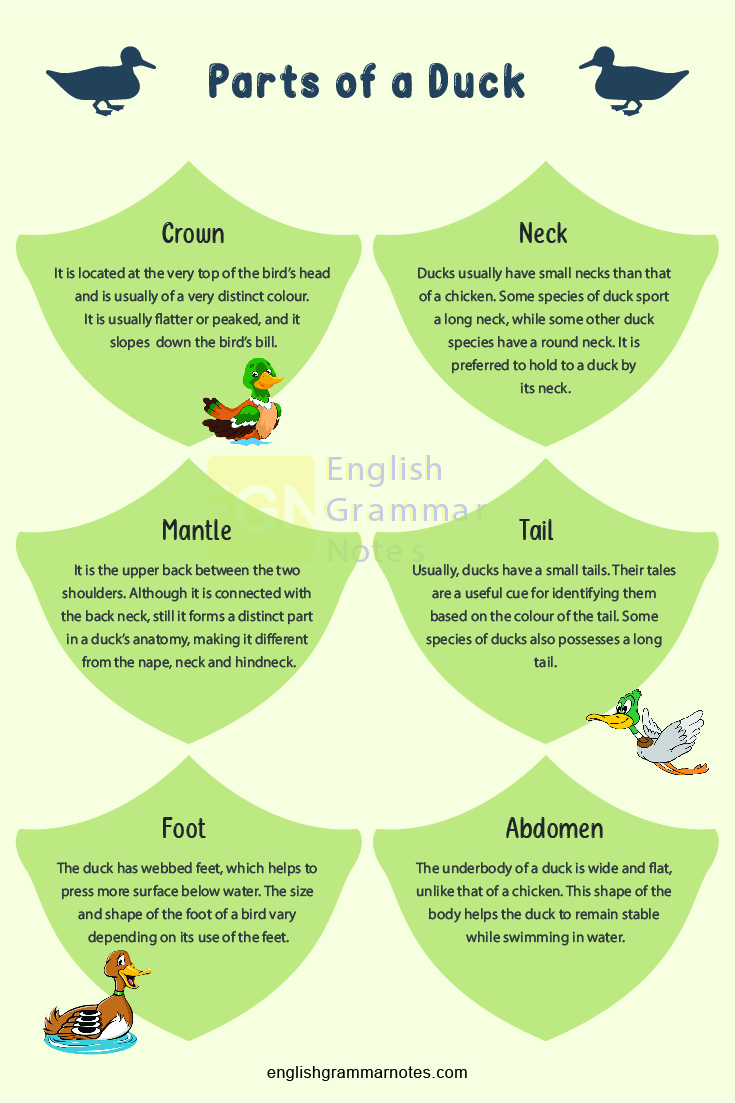Parts of a Duck: Ducks are often considered to be of great value by their keepers. Ducks provide a good source of meat and eggs. In duck anatomy, we do a close study of the external parts of the body of a duck.
Since we all know the value of duck and its contributions to our delicacy, the anatomy of ducks will also look at the parts of the duck to eat.
If you gave a farm or place to cultivate ducks be it for commercial use or domestic, you should know about ts pats. So keeping your need in mind, we have made a list of parts of a Duck with a description.
Study the most important English Vocabulary Words identified by our experts and learn the right vocabulary to use in your day to day conversations
List of Parts of Duck
Name of parts of duck
- Crown
- Eye
- Nape
- Ear
- Neck
- Mantle
- Scapular
- Rump
- Tail
- Undertail coverts
- Foot
- Abdomen/ Belly
- Flank
- Breast
- Throat
- Chin
- Bill
Description of parts of a Duck on the list
Crown
It is located at the very top of the bird’s head and is usually of a very distinct colour. It is usually flatter or peaked, and it slopes down the bird’s bill.
Eye
This organ provides sight to the animal. Ducks have a very good vision, and because of the unusual shape of their eyes, they can see things far and close by simultaneously. In addition, the large gland of the caudomedial protects their eyes from infection.
Nape
It is seen at the back of the bird’s neck. It is the smaller section at the back of the neck. The colour of the nape usually matches with that of the crown or the back and might get extended on the sides of the duck.
Ear
Ducks, like all other vertebrates, have ears, but they are quite different from ours. They don’t have the pinnae; instead, they have small holes behind their eyes, covered by stiff feathers that protect them. Though the structure of their ears is very simple, duck’s sport very sensitive ears.
Neck
Ducks usually have small necks than that of a chicken. Some species of duck sport a long neck, while some other duck species have a round neck. It is preferred to hold to a duck by its neck.
Mantle
It is the upper back between the two shoulders. Although it is connected with the back neck, still it forms a distinct part in a duck’s anatomy, making it different from the nape, neck and hindneck.
Scapular
It refers to the patch of iridescent colour on the secondary wing of a duck. The width and the colour of the speculum vary from species to species. It is visible when the bird is landing, stretching or preening.
Rump
It is the part of the body immediately above the tail. The plumage on the rump helps distinguish between different types of species and helps distinguish between males and females of different species.

Tail
Usually, ducks have a small tails. Their tales are a useful cue for identifying them based on the colour of the tail. Some species of ducks also possesses a long tail.
Undertail Coverts
They are of the same colour as the tailor the belly of the bird. It usually refers to those wings which smoothen the transition between the belly and the tail.
Foot
The duck has webbed feet, which helps to press more surface below water. The size and shape of the foot of a bird vary depending on its use of the feet.
Abdomen/ Belly
The underbody of a duck is wide and flat, unlike that of a chicken. This shape of the body helps the duck to remain stable while swimming in water.

Flank
The wings are a great way of identifying different species of ducks even when they are swimming. Usually, there is a difference between the colours of the primary and the secondary wings.
Breast
It is visible even when the duck is swimming. The breast usually has a specific pattern of bars or mottling. The colour of the breast is often different from the colour of the underparts.
Throat
It is the front part of the neck. The presence of the ring at the end of the neck helps the neck to remain apart from the plumage.
Chin
The duck’s chin is a famous delicacy in Chinese cuisine. It usually serves the lower part of the beak, which is connected to the neck. They served usu, breaded and deep-fried with salt and pepper.
Bill
It stays covered with keratin. As a result, it has a soft and leathery appearance. The end of the bill contains a rigid plate that provides many canals which carry mechanoreceptors nerve ending which provides complex sensory organs. Furthermore, the bill is used to catch flying insects and separate food from the water.